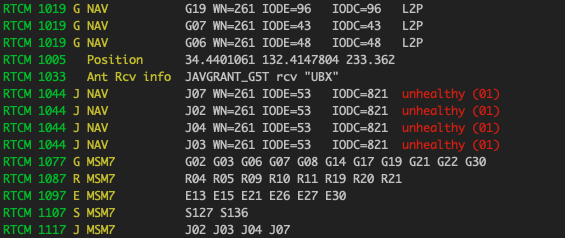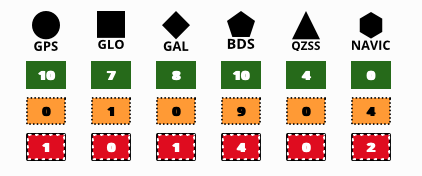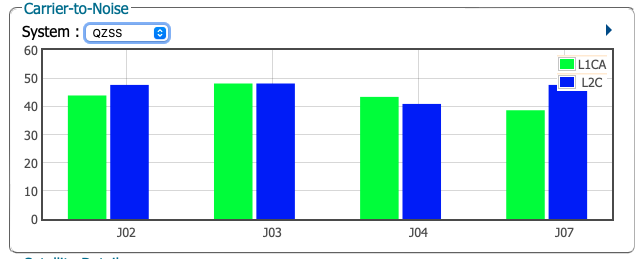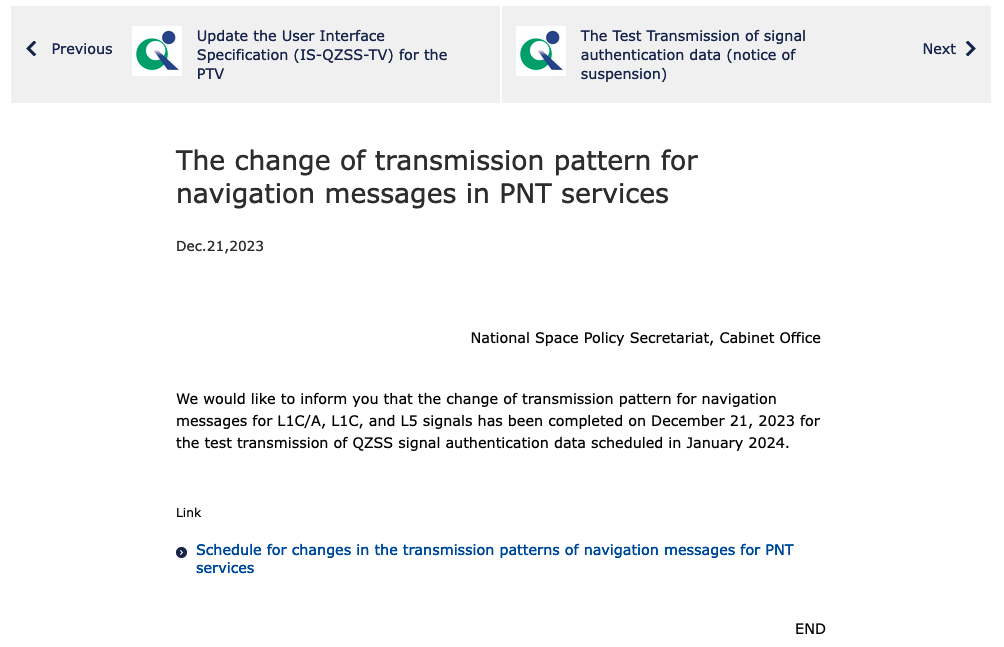Health information expression for QZSS 7-satellite configuration
Introduction
Currently, four satellites of Quasi-Zenith Satellite System (QZSS), or Michibiki, are in operation. In the future, there are plans to increase the number to seven, and then to 11.
On the other hand, navigation messages (digital information sequences including satellite coordinates and time) broadcast by positioning satellites include health information indicating that the satellite is available. I was aware that this health information representation would be changed in preparation for the 7-plane Michibiki system, but I hadn’t actually checked carefully.
Michibiki health information
The ephemeris (information about the satellite itself) in the navigation message broadcast by Michibiki and GPS includes 6-bit health information. Galileo and BeiDou ephemeris also contain health information. I assumed that all of this health information would be zero when everything was working properly.
When I checked the status of the positioning satellites, I found that all Michibiki’s health information was 1 in decimal format.

I thought that Michibiki 2nd satellite J02, Michibiki 3rd satellite J07, Michibiki 4th satellite J03, and Michibiki 1st satellite replacement J04 were all unhealthy.
However, the NovAtel OEM729 receiver and the Septentrio mosaic-go X5 receiver demodulate the signal from the Michibiki satellites.


It can be said that the QZS L6 Tool that I have published is incorrectly displayed as unhealthy. However, according to the RTCM 3 specification I have (RTCM 10403.3, published 2020-04-28), 6-bit all-zero health information can be read as a normal state.

However, with the transition to the Michibiki’s 7-satellite configuration, the L1C/A signal that the signal is transmitted from Michibiki satellites and most widely used will be changed to the L1C/B signal. In accordance with this, health information will also be used for this signal identification (the document is written in Japanese).
According to the Revision History of Michibiki’s Satellite Positioning Service Specification, IS-QZSS-PNT-005, the health information expression was changed in the 4th edition. It was written that. This is a specification issued three years ago.
004 January 25, 2021
3,6,7,8,15,16,37, 39,41,50,118,119,120,125,126,130,135,138,143,144
Change in Tables, Figures and explanations with addition of the new signal “L1C/B”
Decoding health information
I decided to display Michibiki’s health information as follows:
- If the 1st bit or any bit from the 3rd bit to the 5th bit of the health information contains
1, it is unhealthy. The signal name corresponding to each bit up to the 6th bit is also displayed. - When the 6-bit health information is all zero, it is normal and nothing is displayed as health information.
- If the 1st bit of the health information is
0, there is a possibility of a new signal usage indication. If the 2nd or 6th bit is1, it is normal but contains a new signal usage indication, so that signal name will be displayed.
Writing these in Python code looks like this: It’s like Fizz Buzz problem.
if (r.svh[0:1]+r.svh[2:5]).u: # determination of QZSS health including L1C/B is complex, ref.[2], p.47, 4.1.2.3(4)
unhealthy = ''
if r.svh[1]: unhealthy += ' L1C/A'
if r.svh[2]: unhealthy += ' L2C'
if r.svh[3]: unhealthy += ' L5'
if r.svh[4]: unhealthy += ' L1C'
if r.svh[5]: unhealthy += ' L1C/B'
msg += self.trace.msg(0, f' unhealthy ({unhealthy[1:]})', fg='red')
elif not r.svh[0]: # L1 signal is healthy
if r.svh[1]: msg += ' L1C/B' # transmitting L1C/B
if r.svh[5]: msg += ' L1C/A' # transmitting L1C/A
Past navigation messages of Michibiki recorded on 2022-12-13 have all-zero health information as normal operation. I think the health information expression was changed when Navigation message transmission pattern change announcement released on 2023-12-21.

Related article(s):
- Display of MADOCA-PPP ionospheric delay information using QZS L6 Tool 16th August 2024
- QZS L6 Tool output format change 14th April 2024
- Galileo Timing Service Message 6th April 2024
- L1S signal analysis with QZS L6 Tool 11st November 2023
- Galileo HAS live stream 25th July 2023
- HAS message display capability on QZS L6 Tool 5th March 2023
- Trial delivery of QZSS's MADOCA-PPP started 18th August 2022
- Capacity analysis of CLAS satellite augmentation information using QZSS archive data 9th June 2022
- QZSS CLAS tropospheric delay augmentation information for remote islands in Japan 17th May 2022
- Compact SSR display capability on QZS L6 Tool 29th March 2022
- Release of QZS L6 Tool, a positioning satellite message display tool 3rd February 2022